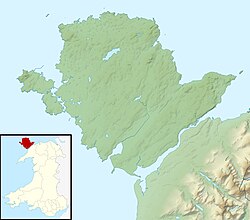Top Qs
Timeline
Chat
Perspective
Hafotty
House in Llansadwrn, Anglesey From Wikipedia, the free encyclopedia
Remove ads
Hafotty, Llansadwrn, Anglesey, Wales is a medieval hall house dating from the mid 14th century. Described in the Gwynedd Pevsner as "one of Anglesey's classic small medieval houses", Hafotty is a Grade I listed building and a scheduled monument.
Remove ads
History
The original house at Hafotty was built of wood.[1] This house is recorded as "Bodiordderch" ("the house of Iordderch"), and has also been called 'Bodarddar'.[2][3] Anthony Emery dates this wooden house to the second quarter of the 14th century.[4] Its original owner was Thomas Norres from Lancashire.[2] In 1535 the house was in the possession of Henry Norris, Constable of Beaumaris Castle.[a][6] By the 16th century, Hafotty had passed to the Bulkeleys, another prominent North Wales family,[b] and had acquired its present name, meaning summer house, or summer dairy.[1] Cadw records extensions to the house in the 16th century, and its re-casing in stone in the 17th.[6] By the 20th century, Hafotty was in a state of some dereliction,[10] but was restored in the 1970s and again in the early 21st century.[5] The house remains in the possession of the Bulkeleys, although under the care of Cadw, and is occasionally open to the public.[2][11]
Remove ads
Architecture and description
The Gwynedd Pevsner considers Hafotty "one of Anglesey's classic small medieval houses".[5] Peter Smith, in his Houses of the Welsh Countryside, categorises it as a three-unit hall house and notes that, despite its "relatively modest" size, it was still a "house of status".[12] Built to an H-plan, and constructed of rubble masonry, it is of two-storeys.[6] Dendrochronology from tree rings dates the beams in the extension to between 1509 and 1553.[2] The interior contains some notable medieval fittings, including fireplaces and window surrounds.[5] The fireplace has a Tudor arch and the inscription in Latin: Si deus nobiscum, quis contra nos ('If God is with us, who can be against us') which is a Bulkeley family motto. The arch also has carvings of the heads of a Saracen and a bull, another Bulkeley family motif.[2] Hafotty is a Grade I listed building[6] and a scheduled monument.[13]
Remove ads
Footnotes
- Although Cadw record the house as still being in the possession of Henry Norris in 1535, Pevsner suggests that it had passed to the Bulkeleys by 1511.[5]
References
Sources
External links
Wikiwand - on
Seamless Wikipedia browsing. On steroids.
Remove ads


